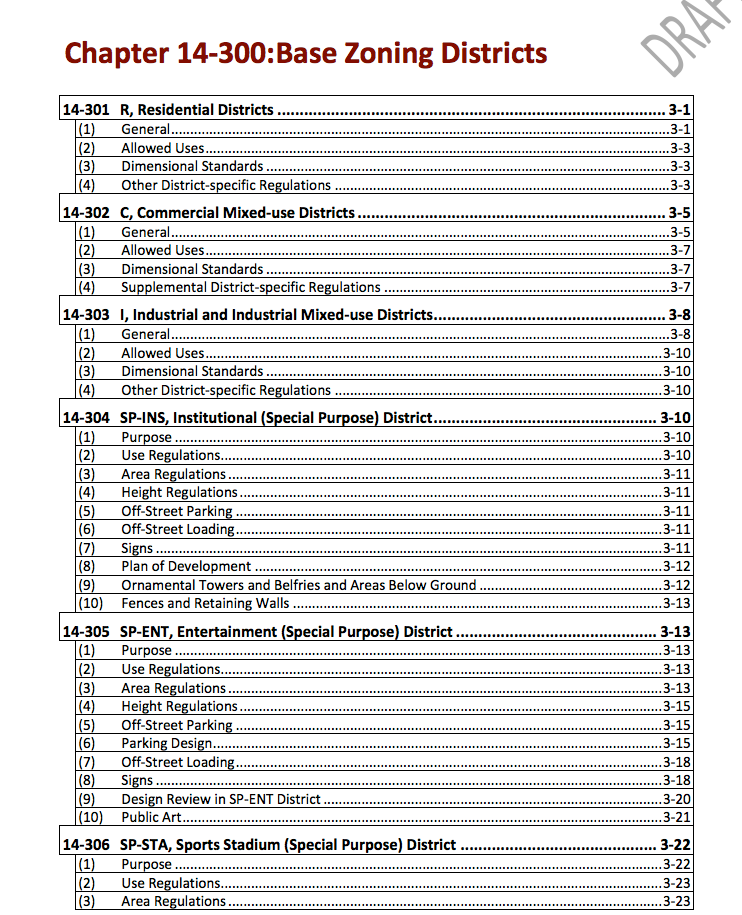Cutting through the Zoning Code: “Base Zoning Districts”

Base zoning districts are pretty much exactly what you’d expect them to be. Chapter 14-300: Base Zoning Districts lay out the core set of zoning classifications that govern what can be built where, and how those buildings can be used. To view the current districts and definitions, visit zoningmatters.org, which provides an easy way to find details on the current districts.
And when you check out the current zoning districts, you can see just how small some of them are. For example, the current R18 district allows larger residential buildings to be converted into multi-family units. According to the Zoning Code Commission, this covers only 0.9 acres of the city, which seems to be the intersection of N. 18th Street and W. Wingohocking Avenue.
The new code consolidates a number of districts that have similar purposes. For example, seven different classifications, largely for buildings including multiple residences (including the tiny R18), are combined into the new RM-1 district. The new districts could—if they work as intended—simplify zoning enforcement, and reduce the amount of cross-referencing property owners need to do when evaluating possible uses of their property.
Philadelphia’s new districts are renamed in a way that hints at their character. The RSD districts stand for “Residential Single-dwelling Detached.” SP-INS stands for “Institutional (Special Purpose) District,” which would include some churches, libraries, and schools. SP-ENT stands for “Entertainment (Special Purpose) District,” which would include, well, casinos.
(Quick aside: did you know that casinos in Philadelphia are required to commission public art at a rate akin to the Percent for Art Ordinance? Neither did I! The more you know . . .)
And so, Chapter 14-300 illustrates how the revised Zoning Code is in many ways a renaming exercise. The SP-ENT district is, in essence, the current Commercial Entertainment District—just with a new name. In all cases, the draft of the code includes a “Previously Known As” column on tables outlining the new districts. If you own a property, or have concerns about one, you can consult the table to see where it will end up in the new zoning scheme.
Here’s a primer on the new names:
Residential Districts: These include three versions of RSD (detached single-dwelling homes), six versions of RSA (attached single-dwelling homes, such as rowhomes and twins), four versions of RM (multi-unit buildings), and three versions of RMX (“residential mixed-use,” which allows for a wider range of businesses than the other classifications).
Commercial Mixed-use Districts: Six of the seven districts fall under the CMX, or “Commercial Mixed-use” label. Different restrictions exist based on the type of commercial activity that exists in city neighborhoods. The district that differs from the CMX districts is CA-1, called a “General (auto-oriented) Commercial District.” Strip malls? Big box stores? Those will be CA-1. We’ll look at permissible commercial activity in more detail when we review Chapter 14-500, “Use Regulations.”
Industrial and Industrial Mixed-use Districts: These include a total of seven districts. I-1 through I-3 are light, medium, and heavy industrial use. I-P is for ports (hence the “P”) and water shipping. ICMX stands for “Industrial Commercial Mixed-use,” which accommodates some commercial activity as a buffer between commercial or residential neighborhoods, and areas of heavier industrial use.
The code also introduces two new industrial districts. The first, IRMX, stands for “Industrial Residential Mixed-use.” According to the code, IRMX will be “a mix of very low-impact manufacturing uses, including artists and artisan manufacturing, and residential and neighborhood-oriented commercial uses.” Think live-work lofts for artists, fashion designers, and yoga teachers. This new district is about the adaptive reuse of Philadelphia’s large number of abandoned industrial sites.
The second is the I-TU district, which, according to the code, will be for “power generation plants, water or wastewater treatment plants, rail yards and similar utility, transportation, or industrial-like activities.” These projects are always large, sometimes noisy, and often messy—I’ll be interested to see whether, after the remapping phase, these districts simply accommodate the sites where these uses are already present, or whether new sites also will be classified as I-TU.
SP Districts: These are “Special Purpose” districts. As mentioned earlier, SP-INS is designed for institutional use, and SP-ENT is largely to accommodate casinos. SP also includes: SP-STA, for what I like to call Stadium Town, but is more commonly known as the South Philadelphia Sports Complex; SP-PO, because even parks and open space need zoning; and SP-AIR, because so does an airport.
The devil, of course, will be in the details. For those districts that will simply change names, nothing much will be different. But for those districts that will be remapped, including the OC district—which the new code eliminates—things will change.
And sad to say, you weren’t lucky: no overlay districts today. But never fear! We’ll get there in our next episode. Here’s a teaser: Center City now extends to Girard Avenue.
Contact the reporter at ngilewicz@planphilly.com
WHYY is your source for fact-based, in-depth journalism and information. As a nonprofit organization, we rely on financial support from readers like you. Please give today.



